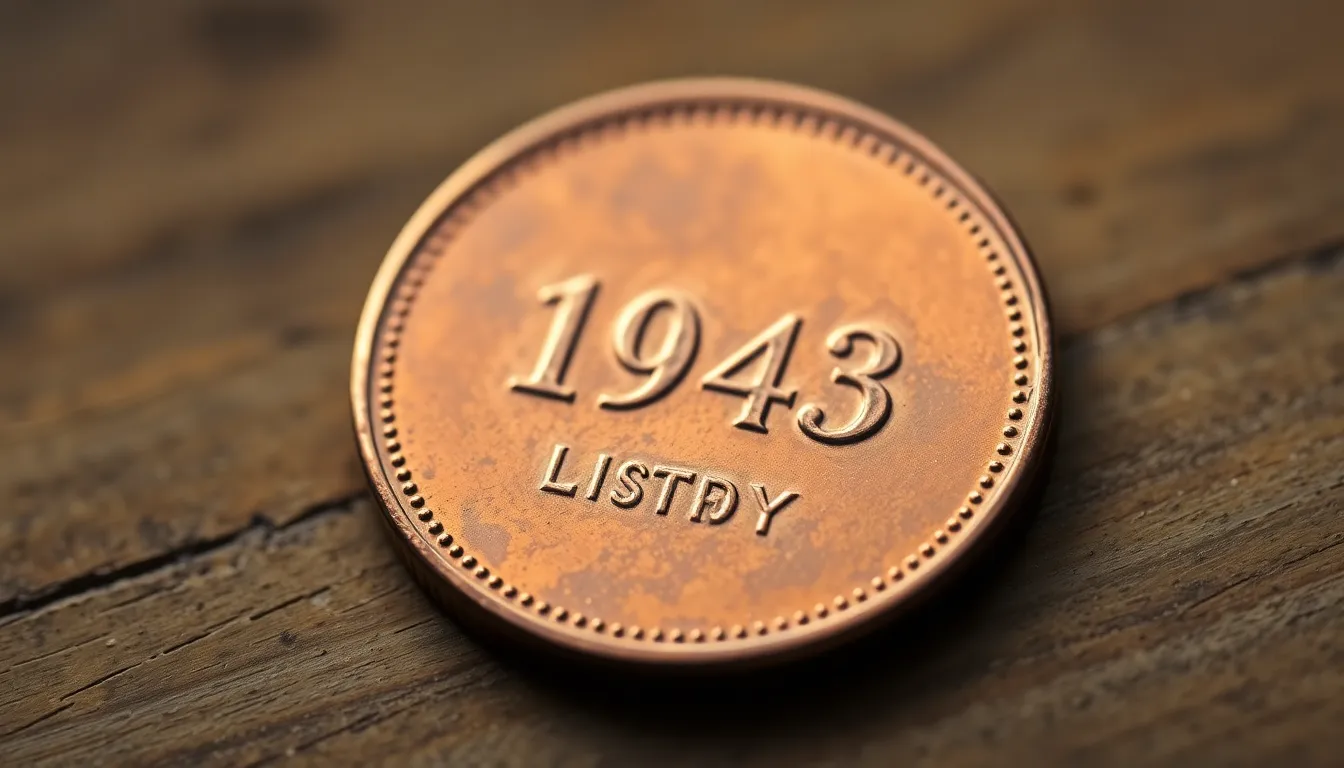Table of Contents
ToggleIn the world of coin collecting, few items spark as much intrigue as the 1943 copper penny. Originally minted in zinc-coated steel due to wartime copper shortages, this rare variant is a surprising treasure that has captivated collectors and investors alike. One particular specimen recently fetched an astonishing $1.7 million at auction, highlighting its rarity and the fervor surrounding numismatic finds.
The story behind the 1943 copper penny is as fascinating as its value. Mistakes during the minting process led to the creation of a few copper coins amidst the steel ones, making them incredibly sought after. For those curious about how a simple penny can hold such immense worth, the journey of this unique coin reveals the intersection of history, rarity, and the passion of collectors.
Overview of the 1943 Copper Penny
The 1943 copper penny represents a notable error in U.S. coinage history. While the U.S. Mint primarily produced steel pennies in 1943 due to copper shortages during World War II, some copper planchets mistakenly entered the minting process. These accidental releases resulted in an extremely rare coin, with only a few specimens known to exist.
Collectors highly value these pennies because of their unique composition and historical context. The rarity stems from the government’s swift move to transition to zinc-coated steel, which left only a handful of copper coins minted that year.
In recent auctions, such as the one where a single 1943 copper penny sold for $1.7 million, collectors and investors demonstrated their enthusiasm for this unique piece of American history. The coin’s allure lies not only in its rarity but also in the fascinating narrative of its creation and the symbolic connection to wartime resource management.
Historical Significance

The 1943 copper penny holds immense historical significance due to its unique creation during a challenging period for the U.S. Mint. This coin reflects a pivotal moment in American history, showcasing the intersection of wartime necessity and coin production.
Coin Minting Process
The minting process of the 1943 copper penny began with the intention to conserve copper for military purposes during World War II. Zinc-coated steel became the standard material for the production of pennies. However, a small number of copper planchets inadvertently remained in the minting facility, leading to the accidental creation of copper pennies. This error exemplifies how operational oversights can result in extraordinary collectibles.
The Transition to Steel
The transition to steel pennies marked a significant change in U.S. coinage. In 1942, copper shortages prompted the U.S. Mint to innovate and produce a new composition for pennies, effectively ceasing copper penny production. By 1943, zinc-coated steel pennies dominated the market, resulting in the rarity of copper coins from that year. Only a handful of these 1943 copper pennies exist today, underscoring their value and importance among collectors and numismatists.
The 1943 Copper Penny Discovery
The discovery of the 1943 copper penny is a captivating tale that demonstrates the intersection of chance and historical significance in numismatics. The rarity of this coin finds its roots in a unique set of circumstances during World War II.
Key Details of the Find
The key details surrounding the 1943 copper penny involve a few critical aspects. One aspect includes the minting error that occurred when some copper planchets were mistakenly mixed with steel planchets at the U.S. Mint. This mistake resulted in an estimated 10 to 20 copper pennies being produced. Another detail rests on the fact that these coins feature the same design as regular pennies but stand out due to their copper composition. Collectors often seek mint marks, particularly from Philadelphia, where these errors primarily originated.
The first documented find of a 1943 copper penny occurred in 1947 when a collector discovered one in change. Following this initial find, additional specimens surfaced, further increasing interest and intrigue among numismatists and the general public alike.
Notable Auctions and Sales
Notable auctions and sales of the 1943 copper penny highlight its extraordinary value and desirability. The highest price recorded for such a penny reached $1.7 million at a 2021 auction, creating significant buzz in the coin-collecting community. Numerous notable sales before this fetched hundreds of thousands of dollars, with examples selling for $1.2 million in 2010 and $800,000 in 2016. Each auction has drawn attention from major collectors and investors, signifying the substantial appreciation of this unique coin over time and reinforcing its place as one of the most sought-after collectibles in American numismatic history.
Market Value and Appraisal
The market value of the 1943 copper penny reflects its rarity and historical significance, with recent auctions highlighting prices as high as $1.7 million. Various factors contribute to the appraisal and valuation of this unique coin.
Factors Influencing Value
- Rarity: The limited number of 1943 copper pennies, estimated at only 10 to 20, significantly enhances their value.
- Condition: Coins in uncirculated or higher grades command higher prices. Mint State grading influences desirability among collectors.
- Provenance: Documented ownership and historical significance can impact market value. Coins with a notable history often fetch higher auction prices.
- Demand: Interest from collectors and investors largely determines price fluctuations. Increased demand leads to higher valuations.
- Market Trends: Economic conditions and trends in the numismatic market affect overall coin values, including the 1943 copper penny.
Comparison with Other Rare Coins
- 1913 Liberty Head Nickel: This coin sold for over $3 million, showcasing valuations above the 1943 copper penny. Its extreme rarity and rich history enhance its appeal to collectors.
- 1894-S Barber Dime: With a known quantity of only 24, this dime regularly fetches prices around $2 million. Its scarcity and collector interest align with the copper penny’s market position.
- 1804 Silver Dollar: Valued at over $4 million, this coin exemplifies the extreme end of collectible coin pricing. Its provenance and legendary status surpass that of the 1943 copper penny.
- 1974 Aluminum Penny: Although a lesser-known error coin, it has recently seen prices reach $1 million. Its rarity also aligns with limited error coins on the market.
By analyzing these coins, it’s evident that the 1943 copper penny holds a significant place in the numismatic community, reflecting both its unique creation story and the factors that influence its market value.
Collectors and the 1943 Copper Penny
The 1943 copper penny holds immense appeal for various collectors due to its rarity and historical context. This unique coin attracts both seasoned numismatists and new enthusiasts eager to learn about its fascinating background.
Target Audience for Collectors
- Numismatists: Experienced collectors focus on historical and rare coins, understanding the significance of the 1943 copper penny in U.S. coinage history.
- Investors: Financial investors see potential returns, driven by the coin’s high market value and limited availability.
- Casual Collectors: Hobbyists gather coins for personal enjoyment, often motivated by curiosity about notable pieces like the 1943 copper penny.
- History Buffs: Individuals passionate about World War II history may find the coin’s backstory compelling, further fueling interest in its collection.
- Young Collectors: Young enthusiasts participate in numismatic programs to learn the importance of coins, with the 1943 copper penny being a captivating topic.
Tips for Aspiring Collectors
- Research: Understand the history and significance of the 1943 copper penny to appreciate its value fully.
- Join Clubs: Connect with numismatic clubs or online forums to gain insights and share experiences with fellow collectors.
- Attend Auctions: Participate in coin auctions to familiarize oneself with market trends and valuations of rare coins.
- Verify Authenticity: Ensure any purchase comes with proper certification or grading to avoid counterfeit coins.
- Network: Build relationships with dealers and experts to access valuable information and opportunities within the collector community.
The 1943 copper penny stands as a remarkable testament to the quirks of history and minting errors. Its scarcity and unique backstory have captivated collectors and investors alike, driving its value to astonishing heights. With a recent auction price of $1.7 million, it’s clear that this coin is more than just currency; it’s a piece of American history that reflects the challenges of its time.
As interest in numismatics continues to grow, the 1943 copper penny remains a shining example of how rarity and historical significance can create exceptional value in the world of collectibles. Whether for seasoned collectors or newcomers, this coin offers a fascinating entry point into the rich tapestry of U.S. coinage.



